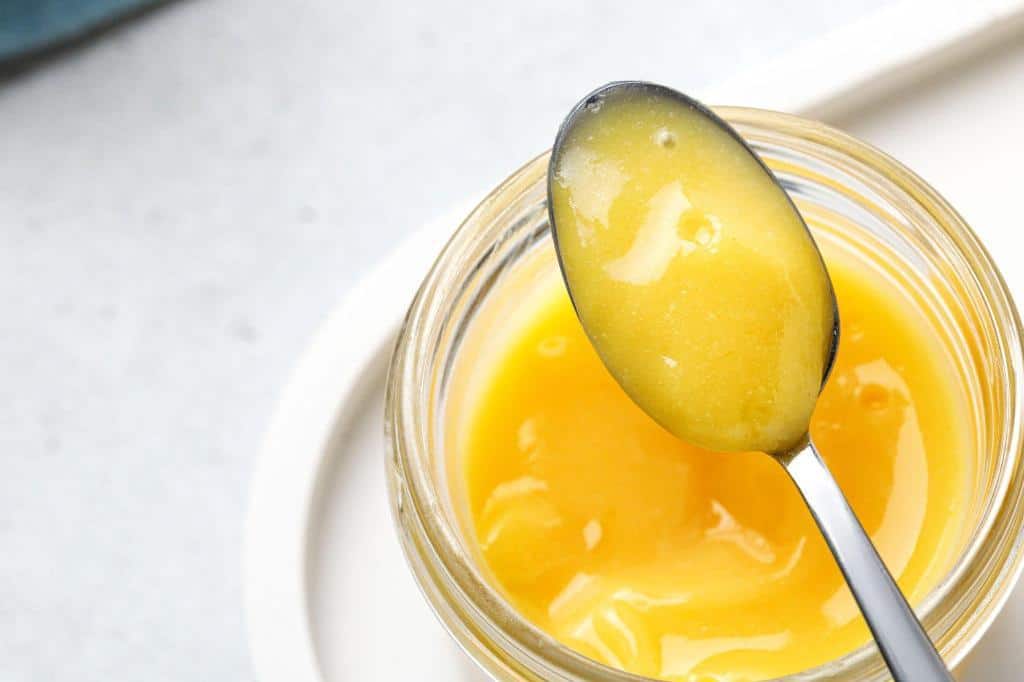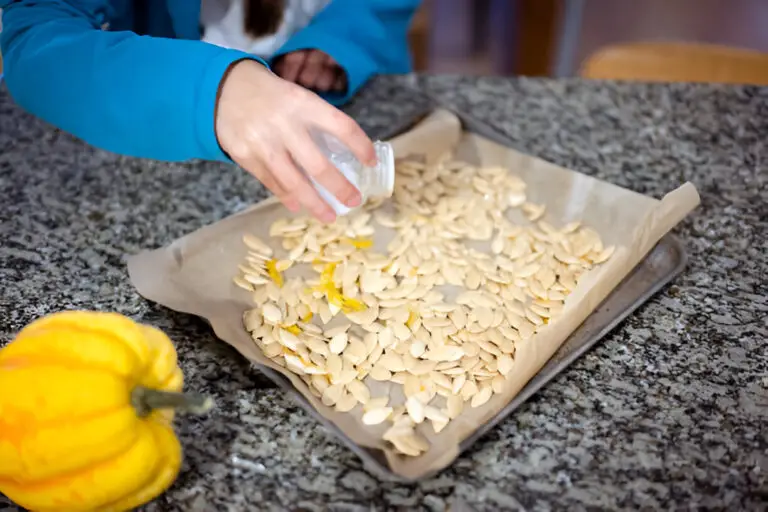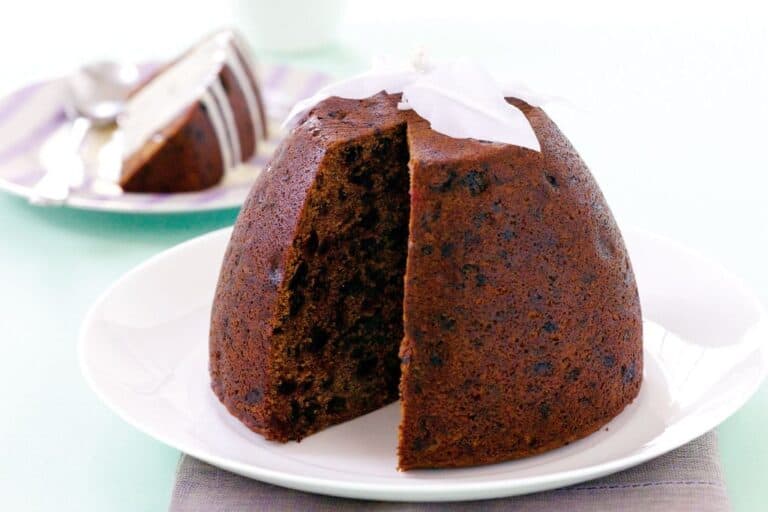How Thick Should Lemon Curd Be? (Before Taking off the Heat)

Lemon curd is a delicious, zesty spread that can be used in a variety of ways. Whether you’re spreading it on toast or using it as a filling for cakes and tarts, lemon curd is always a welcome addition.
Lemon curd is a tart, thickened sauce made from lemons, sugar, eggs, and butter. It’s often used as a filling for pies and tarts or as a spread for toast and scones.
The key to making lemon curd is to cook it long enough so that it thickens properly but not so long that it becomes rubbery or overly dense.
So, how thick should lemon curd be before taking off the heat? The best way to test it is to spoon a small amount onto a plate and then run your finger through it.
If the curd holds its shape and doesn’t run back together, it’s thick enough. If it’s still too thin, cook it for a few minutes longer and test it again. Once you’ve reached the perfect consistency, take the lemon curd off the heat and let it cool slightly before using.
How Thick Should Lemon Curd Be?
The ideal lemon curd thickness depends on what your intention is for. Lemon curd should be just thick enough to spread on toast or scones, but not too thick to match the filling of a lemon pie.
When the curd is the right consistency, it will stick to the back of a spoon and stay in place when you pass your finger through it.
When I make a batch of homemade lemon curd recipe, I like to make it on the thicker side so that it can be easily spread over toast and, at the same time, be used as a filling for cakes and tarts.
If you want the consistency to be thinner, just keep adding more lemon juice until you get the right consistency.
The best way to achieve the perfect thickness is to cook the lemon curd over low heat and stir often. This method takes patience, but it will result in a delicious, thick lemon curd that is worth the wait.
So, experiment until you find the perfect thickness for your needs!
How Do You Fix Too-thick Lemon Curd?
Too-thick is the most common lemon curd mistake that can be easily fixed. There are a few different methods that can be used to thin out lemon curd, depending on what you have on hand.
One simple way to fix too-thick lemon curd is to add a bit of water or milk and stir until the desired consistency is reached. If you don’t have any water or milk on hand, you can also thin out the lemon curd by whisking in some additional lemon juice.
Start with just a tablespoon or two and mix well until the desired consistency is reached. This will help to thin it out and make it more widely available.
You may try another way to thin out lemon curd by putting it in a food processor or blender and blending until smooth.
If the lemon curd is still too thick after these adjustments, you can try heating it over low heat until it reaches the desired consistency.
Can Lemon Curd Be Made in the Microwave?
While it is traditionally made on the stovetop, it is possible to make this lemon curd recipe in the microwave. It takes a bit of care to make sure it doesn’t curdle.
To make lemon curd in the microwave, be sure to use fresh lemon juice. This will give your curd the best flavor and prevent it from curdling.
Start by whisking together lemon juice, sugar, eggs, and butter in a microwave-safe bowl. Whisk the ingredients together thoroughly, before microwaving . This will help them emulsify and prevent clumping.
Then, heat the mixture in the microwave on high power for two minutes. Stir well and then heat it again for two minutes.
Continue to heat and stir at two-minute intervals until the mixture thickens and coats the back of a spoon.
Be careful not to overcook the lemon curd, or it will become grainy. Take the lemon curd off of the heat immediately. Lemon curd will continue to thicken as it cools. Once it’s done, pour it into a clean jar and store it in the fridge for up to two weeks.
Why Is My Lemon Curd Runny & Watery?
Sometimes lemon curd can be runny and watery, which can ruin your dessert or breakfast. There are several possible causes for this, and fortunately, there are several solutions.
One reason why your lemon curd may be runny is that you didn’t cook it long enough. Lemon curd should be cooked over low heat until it thickens and coats the back of a spoon.
When making lemon curd, the eggs need to be cooked until they reach a temperature of 160 degrees F. If they’re not cooked long enough, the proteins in the egg will remain unfolded and the lemon curd will be runny.
Another reason that your lemon curd may be watery is that you added too much liquid to it. Lemon curd should have a ratio of one cup of lemon juice to each egg. If you’ve added more than that, your lemon curd will be runny and watery.
So how do you fix it? You can add more sugar to it, but you’ll end up with a super sweet lemon curd. Or you can save your homemade lemon curd for baking recipes and use it for cakes, pies, and other baked desserts.
Should You Strain the Lemon Curd?
When it comes to lemon curd, don’t be afraid to give it a good strain. This will help to remove any lumps or bumps that might be lurking in the mixture.
There are a few things to consider when making this decision. If you want a smooth, silky texture, then straining the lemon curd is definitely the way to go.
However, if you don’t mind a few chunks of lemon zest in your spread, then you can skip this step.
Another thing to keep in mind is that straining the lemon curd will remove some of the natural pectin from the mixture. This means that it may not set up as well as it would if you hadn’t strained it.
How To Make the Perfect Lemon Curd
Lemon curd is a delicious tart spread made from scratch with just a few simple ingredients. It’s perfect for spreading on toast, using as a filling in cakes or tarts, or simply eating by the spoonful! Here’s how to make the perfect lemon curd.
Ingredients:
- 1/2 cup (100g) sugar
- 1/2 cup (120ml) freshly squeezed lemon juice
- 3 egg yolks
- 1/4 cup (60g) butter, at room temperature
- 1 teaspoon grated lemon zest
Instructions:
- Combine sugar, lemon juice, and egg yolks in a medium saucepan over low heat.
- Cook, whisking constantly, until mixture thickens and coats the back of a spoon.
- Remove from heat and gradually whisk in 1 tablespoon of butter.
- Stir in lemon zest, then pour curd into a glass jar to cool.
- Refrigerate until completely chilled, covered.
- Serve with scones or shortbread cookies spread!
Tips To Make Lemon Curd Without Eggs
Lemon curd is a delicious and tangy spread that can be used in a variety of ways. While most recipes for lemon curd call for eggs, it is possible to make a delicious egg-free version. Here are some tips for making lemon curd without eggs:
- Start by heating the lemon juice and sugar in a saucepan over low heat. Stir until the sugar has dissolved.
- Once the sugar has dissolved, increase the heat and bring the mixture to a boil, then remove from the heat for 1 minute.
- Add the butter to the hot mixture and stir until melted. Then, add the cornstarch mixture and whisk until well combined.
- Put the mixture back in the pan and cook it over low heat, stirring it all the time, until it thickens.
This recipe is simple to create from scratch on the stovetop without the need of a double boiler or the use of eggs.
Conclusion
How thick should lemon curd be is not something everyone agrees on. There is no ideal thickness for lemon curd, as the thickness will depend on personal preference and the particular recipe you are using it for.
However, as a general guide, lemon curd should be thick enough to coat the back of a spoon without running off. A thick lemon curd will have a rich, creamy texture that is perfect for spreading on toast or using as a filling in cakes and tarts. A thin lemon curd, on the other hand, will be runny and lack flavor.
If your lemon curd is too thin, you can cook it for longer to achieve the desired consistency. Conversely, if it is too thick, you can add a little more lemon juice or water to thin it out.






